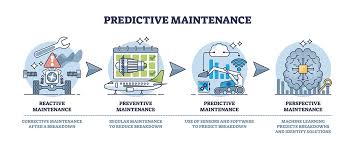Predictive and Preventive Maintenance on Machinery: A Comprehensive Guide 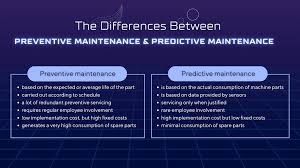
In the realm of machinery management, maintenance plays a critical role in ensuring operational efficiency, extending equipment life, and minimizing downtime. Among the various strategies employed, predictive and preventive maintenance are two of the most effective methodologies. This comprehensive guide explores the principles, differences, benefits, and best practices associated with predictive and preventive maintenance, along with the technologies that support these approaches.
- Understanding Maintenance Strategies
1.1 The Importance of Maintenance
Maintenance is essential for the longevity and reliability of machinery. Poor maintenance can lead to unexpected failures, increased operational costs, and safety hazards. A well-structured maintenance strategy can significantly reduce the risk of equipment failure and enhance productivity.
1.2 Types of Maintenance
Maintenance strategies can generally be categorized into three primary types:
- Reactive Maintenance: This is performed after a failure has occurred, often leading to unplanned downtime and higher repair costs.
- Preventive Maintenance (PM): Scheduled maintenance tasks performed to reduce the likelihood of equipment failures. This approach is based on time intervals or usage metrics.
- Predictive Maintenance (PdM): Uses data analysis and monitoring tools to predict when maintenance should be performed. This allows for maintenance activities to be carried out just before failure is expected, optimizing resources and minimizing downtime.
- Preventive Maintenance (PM)
2.1 Definition and Principles
Preventive maintenance involves regularly scheduled inspections, adjustments, and replacements of parts to prevent unexpected failures. The primary objective of PM is to maintain machinery in good working order and to prevent breakdowns.
2.2 Key Components of Preventive Maintenance
- Scheduled Inspections: Regularly checking machinery for wear and tear, ensuring all components function correctly.
- Lubrication: Applying lubricants to moving parts to minimize friction and wear.
- Adjustments: Making necessary adjustments to alignments, tensions, and settings based on manufacturer specifications.
- Parts Replacement: Replacing parts at regular intervals to prevent failures, even if they appear to be functioning properly.
2.3 Benefits of Preventive Maintenance
- Reduced Downtime: Regular maintenance minimizes the chances of unexpected failures, leading to less downtime.
- Increased Equipment Lifespan: Consistent care prolongs the life of machinery, reducing the need for costly replacements.
- Improved Safety: Well-maintained equipment is less likely to fail in ways that could pose safety hazards to operators.
- Cost Savings: While preventive maintenance incurs costs, it is often less expensive than the costs associated with major repairs and downtime.
2.4 Challenges of Preventive Maintenance
- Scheduling Conflicts: Aligning maintenance schedules with operational needs can be challenging.
- Resource Allocation: Requires adequate manpower and materials, which may strain budgets if not properly managed.
- Over-Maintenance: Performing maintenance too frequently can lead to unnecessary costs and can sometimes exacerbate wear on components.
- Predictive Maintenance (PdM)
3.1 Definition and Principles
Predictive maintenance involves using advanced data analytics and monitoring techniques to predict when maintenance should occur. This proactive approach allows maintenance to be performed just before a failure is likely to occur, optimizing the use of resources.
3.2 Key Components of Predictive Maintenance
- Condition Monitoring: The continuous measurement of equipment performance parameters such as vibration, temperature, and sound. Techniques include:
- Vibration Analysis: Detects imbalance, misalignment, and bearing faults.
- Thermal Imaging: Identifies overheating components that could lead to failure.
- Oil Analysis: Monitors lubricant condition and identifies wear particles.
- Data Analytics: The use of algorithms and machine learning to analyze historical and real-time data to forecast failures.
- Automated Alerts: Systems that notify maintenance teams of potential issues before they result in failures.
3.3 Benefits of Predictive Maintenance
- Reduced Maintenance Costs: By performing maintenance only when necessary, organizations can reduce labor and materials costs.
- Enhanced Equipment Reliability: Predictive maintenance helps ensure machinery operates at optimal conditions, minimizing the risk of breakdowns.
- Increased Production Efficiency: Less unplanned downtime leads to more consistent production schedules.
- Informed Decision-Making: Real-time data provides valuable insights, allowing for better planning and resource allocation.
3.4 Challenges of Predictive Maintenance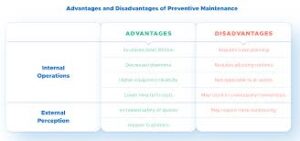
- High Initial Investment: Implementing PdM technologies requires investment in sensors, data analysis tools, and training.
- Data Overload: The amount of data generated can be overwhelming, necessitating effective data management strategies.
- Skill Gaps: Requires trained personnel to interpret data and make maintenance decisions.
- Comparing Preventive and Predictive Maintenance
While both preventive and predictive maintenance aim to minimize downtime and prolong equipment life, they do so in different ways.
4.1 Key Differences
| Feature | Preventive Maintenance | Predictive Maintenance |
| Timing | Scheduled intervals | Based on condition analysis |
| Cost | Lower initial costs, but can lead to unnecessary maintenance | Higher initial costs, potentially lower long-term costs |
| Data Requirement | Minimal | High; relies on data analytics |
| Downtime Impact | Can lead to unnecessary downtime | Minimizes downtime through timely interventions |
| Resource Allocation | Fixed schedule | Flexible, based on actual needs |
4.2 Choosing the Right Strategy
The choice between preventive and predictive maintenance depends on various factors, including:
- Type of Equipment: Critical machinery may benefit more from predictive maintenance, while less critical equipment can be managed with preventive strategies.
- Operational Environment: In high-demand environments, predictive maintenance may offer significant advantages in terms of uptime and efficiency.
- Budget Constraints: Organizations with limited budgets may initially implement preventive maintenance before transitioning to predictive maintenance as resources allow.
- Implementing a Maintenance Strategy
5.1 Steps for Implementing Preventive Maintenance
- Assessment of Equipment: Evaluate the machinery and determine maintenance needs based on usage patterns and manufacturer recommendations.
- Development of a Maintenance Schedule: Create a calendar for regular inspections and maintenance tasks.
- Training Staff: Ensure that maintenance personnel are trained in best practices and understand the importance of preventive measures.
- Documentation: Maintain records of maintenance activities, including tasks performed, parts replaced, and any observations noted during inspections.
5.2 Steps for Implementing Predictive Maintenance
- Data Collection: Install sensors and monitoring equipment to gather real-time data on machinery performance.
- Data Analysis: Use analytics tools to process the data, looking for patterns that indicate potential failures.
- Integration with Maintenance Planning: Incorporate predictive insights into maintenance scheduling, allowing for flexible adjustments based on actual conditions.
- Continuous Improvement: Regularly review predictive maintenance outcomes to refine processes and improve accuracy.
- Technologies Supporting Maintenance Strategies
6.1 Condition Monitoring Technologies
- IoT Sensors: Internet of Things (IoT) devices can monitor various parameters in real time, providing a wealth of data for predictive maintenance.
- Cloud Computing: Enables the storage and processing of large volumes of data collected from machinery, facilitating remote monitoring and analysis.
- Machine Learning: Algorithms can learn from historical data, improving the accuracy of failure predictions over time.
6.2 Maintenance Management Software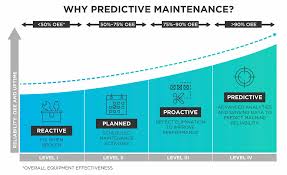
- CMMS (Computerized Maintenance Management System): A software solution that helps organizations schedule maintenance, track work orders, and manage inventory.
- EAM (Enterprise Asset Management): Comprehensive systems that integrate all aspects of asset management, including maintenance, procurement, and performance analysis.
- Case Studies
7.1 Case Study: Manufacturing Plant
A large manufacturing plant implemented a predictive maintenance strategy using IoT sensors to monitor critical machinery. By analyzing vibration and temperature data, they were able to predict failures in their motors and pumps. As a result, they reduced unplanned downtime by 30% and saved 25% in maintenance costs over a year.
7.2 Case Study: HVAC Systems
An HVAC company transitioned from a preventive maintenance approach to predictive maintenance for its rooftop units. By using thermal imaging and pressure sensors, they could identify issues before they resulted in failures. This shift improved service efficiency, reduced emergency repairs by 40%, and enhanced customer satisfaction.
- Future Trends in Maintenance
8.1 Industry 4.0 and Smart Maintenance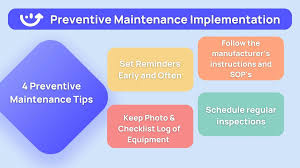
The integration of Industry 4.0 principles into maintenance strategies is set to revolutionize how organizations approach machinery management. Key trends include:
- Increased Automation: Automated systems will manage data collection and analysis, reducing the need for manual intervention.
- Artificial Intelligence (AI): AI will enhance predictive analytics, allowing for more accurate forecasting of maintenance needs based on complex data sets.
8.2 Sustainability and Environmental Considerations
As industries move towards more sustainable practices, maintenance strategies will increasingly focus on minimizing waste and energy consumption. This includes:
- Energy-Efficient Operations: Implementing maintenance practices that enhance the energy efficiency of machinery.
- Lifecycle Analysis: Considering the environmental impact of machinery throughout its lifecycle, from production to disposal.
- Conclusion
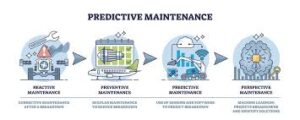
Predictive and preventive maintenance are essential strategies for optimizing the performance and longevity of machinery. While preventive maintenance offers a structured approach to maintaining equipment, predictive maintenance leverages data and analytics to anticipate failures and optimize maintenance schedules.
Implementing these strategies effectively requires careful planning, investment in technology, and ongoing evaluation to adapt to changing operational needs. By adopting a comprehensive maintenance approach, organizations can enhance productivity, reduce costs, and ensure the safety and reliability of their machinery.

